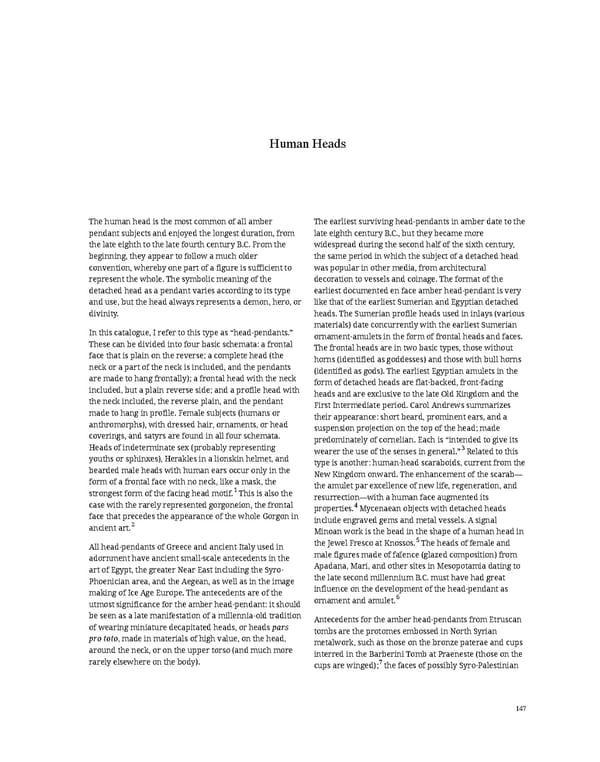Human Heads The human head is the most common of all amber The earliest surviving head-pendants in amber date to the pendant subjects and enjoyed the longest duration, from late eighth century B.C., but they became more the late eighth to the late fourth century B.C. From the widespread during the second half of the sixth century, beginning, they appear to follow a much older the same period in which the subject of a detached head convention, whereby one part of a figure is sufficient to was popular in other media, from architectural represent the whole. The symbolic meaning of the decoration to vessels and coinage. The format of the detached head as a pendant varies according to its type earliest documented en face amber head-pendant is very and use, but the head always represents a demon, hero, or like that of the earliest Sumerian and Egyptian detached divinity. heads. The Sumerian profile heads used in inlays (various materials) date concurrently with the earliest Sumerian In this catalogue, I refer to this type as “head-pendants.” ornament-amulets in the form of frontal heads and faces. These can be divided into four basic schemata: a frontal The frontal heads are in two basic types, those without face that is plain on the reverse; a complete head (the horns (identified as goddesses) and those with bull horns neck or a part of the neck is included, and the pendants (identified as gods). The earliest Egyptian amulets in the are made to hang frontally); a frontal head with the neck form of detached heads are flat-backed, front-facing included, but a plain reverse side; and a profile head with heads and are exclusive to the late Old Kingdom and the the neck included, the reverse plain, and the pendant First Intermediate period. Carol Andrews summarizes made to hang in profile. Female subjects (humans or their appearance: short beard, prominent ears, and a anthromorphs), with dressed hair, ornaments, or head suspension projection on the top of the head; made coverings, and satyrs are found in all four schemata. predominately of cornelian. Each is “intended to give its Heads of indeterminate sex (probably representing wearer the use of the senses in general.”3 Related to this youths or sphinxes), Herakles in a lionskin helmet, and type is another: human-head scaraboids, current from the bearded male heads with human ears occur only in the New Kingdom onward. The enhancement of the scarab— form of a frontal face with no neck, like a mask, the the amulet par excellence of new life, regeneration, and strongest form of the facing head motif.1 This is also the resurrection—with a human face augmented its case with the rarely represented gorgoneion, the frontal properties.4 Mycenaean objects with detached heads face that precedes the appearance of the whole Gorgon in include engraved gems and metal vessels. A signal ancient art.2 Minoan work is the bead in the shape of a human head in the Jewel Fresco at Knossos.5 The heads of female and All head-pendants of Greece and ancient Italy used in adornment have ancient small-scale antecedents in the male figures made of faïence (glazed composition) from art of Egypt, the greater Near East including the Syro- Apadana, Mari, and other sites in Mesopotamia dating to Phoenician area, and the Aegean, as well as in the image the late second millennium B.C. must have had great making of Ice Age Europe. The antecedents are of the influence on the development of the head-pendant as ornament and amulet.6 utmost significance for the amber head-pendant: it should be seen as a late manifestation of a millennia-old tradition Antecedents for the amber head-pendants from Etruscan of wearing miniature decapitated heads, or heads pars tombs are the protomes embossed in North Syrian pro toto, made in materials of high value, on the head, metalwork, such as those on the bronze paterae and cups around the neck, or on the upper torso (and much more interred in the Barberini Tomb at Praeneste (those on the rarely elsewhere on the body). cups are winged);7 the faces of possibly Syro-Palestinian 147
 Ancient Carved Ambers in the J. Paul Getty Museum Page 156 Page 158
Ancient Carved Ambers in the J. Paul Getty Museum Page 156 Page 158
